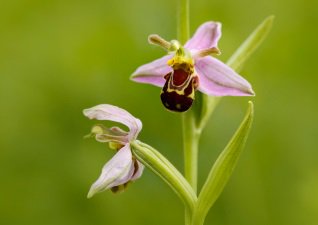Page contents
- What is chalk grassland?
- Why is it important and how do we look after chalk grassland?
- What you can see here:
- The best sites to see chalk grassland in Surrey

What is chalk grassland?
Chalk grassland is a unique, specialised and fragile habitat, important for landscape and historical value as well as for wildlife.
Lime-rich, but low in nutrients, the thin soil holds little water and heats up quickly. These stressed conditions stop the dominant lush grasses from taking over. This allows a diverse range of smaller herbs and lower growing plants to flourish.
Lowland chalk grassland is mainly confined to the North and South Downs, from Kent to Wiltshire and Dorset. A variety of sites are found in Surrey and south London.
Why is it important and how do we look after chalk grassland?
Chalk grassland is exceptionally rich in plants and insects and up to fifty different types of plants and wildflowers can be found in one square metre, many of them rare species.
Chalk grassland was originally created by the clearance of trees and scrub about 9,000 years ago and maintained by grazing livestock. There has been a sharp decline in the amount of chalk grassland in the last fifty years, with one of the biggest threats being lack of grazing. Sites must be managed to maintain their quality and to stop coarse grasses, scrub and trees from taking over and shading out the diverse range of plants and flowers. If managed correctly, no single species of plant can dominate and this creates a very diverse habitat - one of the richest in western Europe.
Grazing by sheep, goats or cattle is the best form of management and the type of animal used depends on the site. Goats are good at reducing areas of scrub, whereas sheep and cattle are good for maintaining the grass.
What you can see here
Types of flowers
- Many orchid species, such as fragrant and pyramidal varieties
- St John's wort
- Bird's-foot trefoil
- Wild carrot
- Cowslip
- Wild marjoram
- Greater yellow rattle is rare nationally but found abundantly in grasslands across Surrey.
Find a patch of meadow to sit down and even if you don't know the varieties, you'll find many different wildflowers to discover around you.
Birds, butterflies and snails
- Nearly a third of all UK butterfly species can be found on chalk grassland, including the small blue, green hairstreak and silver-spotted skipper.
- The large Roman snail, introduced to Britain by the Romans for food, thrives on chalk grassland.
- Bird species include green woodpecker and linnet.
- Listen out for the high-pitched trill of a skylark overhead.
- Yellowhammers, kestrels and sparrowhawks can be found nesting in quarries.
The best sites to see chalk grassland in Surrey
One of the best ways to discover chalk grassland and wildflower meadows is to walk the North Downs Way national trail. There are also circular self-guided walks off the North Downs Way trail in Surrey.
You'll also be rewarded with great views towards the South Downs and the Weald:
- Pewley Down above Guildford
- Newlands Corner and Albury Downs
- Shere Woodlands and White Down above Gomshall and Abinger
- Ranmore Common and Denbies Hillside above Dorking
- Reigate Hill. The Inglis Memorial used to be a drinking fountain for cattle-grazing, but is now a picturesque rest point in the hills
- Box Hill, historically popular with the Victorians wanting to get out of London to visit the countryside
- The old chalk quarries of Brockham Limeworks and Betchworth quarry. The derelict remains of the lime kiln at Brockham, a grade II listed building, is now a winter roost for many species of bat
- Chalk grassland sites in east Surrey around Croydon, Chaldon and Chipstead are now part of the South London Downs National Nature Reserve, like Farthing Downs, Happy Valley and Quarry Hangars. Riddlesdown is another derelict chalk quarry.
Last but not least, pay a visit to Howell Hill in East Ewell to find a flat site of chalk grassland created in the 1960s when former school playing fields were left unmanaged. This allowed many varieties of chalk grassland-loving plants to establish. There have been 260 varieties of flowering plants recorded on this site.
Find out more about the management of chalk grassland on our Downlands Partnership web page. There are many opportunities to volunteer to help.

